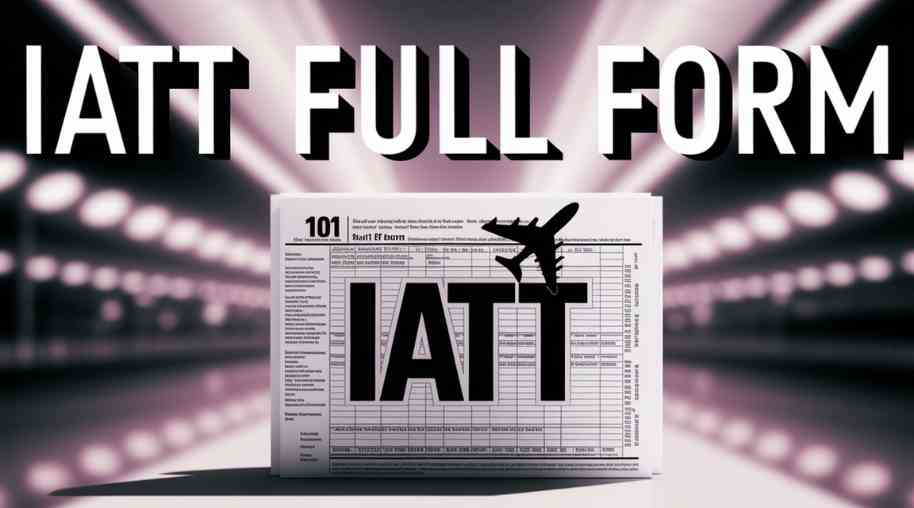IATT Full Form-Inland Air Travel Tax
by Shashi Gaherwar
0 1951
Inland Air Travel Tax: Purpose, Impact, and Global Perspectives
The Inland Air Travel Tax is a government-imposed charge on domestic air travel to regulate the airline industry, generate revenue, and sometimes address environmental concerns. It varies by country and can influence airline ticket prices, passenger demand, and economic development. This article explores the purpose, effects, and global implementation of Inland Air Travel Taxes.

What is Inland Air Travel Tax?
The Inland Air Travel Tax is a levy imposed on domestic flights within a country. Governments use this tax for multiple reasons, including infrastructure funding, environmental sustainability, and economic regulation. The tax is typically included in ticket prices and collected by airlines on behalf of the government.
Purpose of Inland Air Travel Tax
The tax serves several key objectives:
- Revenue Generation
- Governments use the tax revenue to fund airport infrastructure, air traffic management, and national budgets.
- Environmental Regulation
- Some governments impose air travel taxes as a carbon tax to discourage excessive domestic air travel and promote eco-friendly alternatives like rail transport. [](https://www.tandfonline.com/doi/full/10.1080/09669582.2022.2115050)
- Market Regulation
- Taxes help regulate competition in the airline industry, ensuring that budget carriers and national airlines operate fairly within the aviation market.
- Encouraging Alternative Transport
- High air travel taxes can promote other forms of transport, such as high-speed rail and buses, which may be more environmentally friendly.
Impact of Inland Air Travel Tax
The effect of air travel taxes varies based on factors such as tax rates, airline pricing strategies, and consumer behavior.
- Impact on Airline Industry
- Airlines may pass the tax burden to passengers through higher ticket prices.
- Budget airlines may face greater pressure, affecting their affordability and profitability. [](https://www.sciencedirect.com/science/article/pii/S0965856423003129)
- Regional airports may experience reduced demand, impacting local economies.
- Economic Impact
- Higher taxes can discourage air travel, reducing revenue for tourism-related industries like hotels, restaurants, and transportation services. [](https://blog.aci.aero/airport-economics/taxation-of-international-air-transport-when-costs-exceed-economic-benefits/)
- Conversely, governments benefit from increased tax revenue, which can be reinvested in aviation infrastructure and public services.
- Environmental Impact
- Inland Air Travel Tax encourages travelers to consider lower-emission transport modes such as railways and electric buses. [](https://www.sciencedirect.com/science/article/pii/S2590198221001123)
- It supports global efforts to reduce carbon footprints and combat climate change. [](https://www.sciencedirect.com/science/article/pii/S0965856423003129)
Global Perspectives on Inland Air Travel Tax
Different countries implement the tax in various ways, reflecting diverse economic and environmental priorities.
- United Kingdom – Air Passenger Duty (APD)
- The UK applies an Air Passenger Duty (APD) on domestic and international flights.
- The tax varies based on flight distance and class of travel, with rates increasing from April 2026, adding £2 per passenger for economy tickets on1904 on short-haul international flights. [](https://www.euronews.com/travel/2024/11/11/planning-your-next-flight-how-europes-different-air-passenger-taxes-impact-your-wallet)
- European Union – Environmental Taxes
- Many European countries impose carbon-related aviation taxes to support environmental sustainability.
- France, Germany, and Sweden have introduced eco-taxes on flights, with rates varying by destination and travel class. [](https://www.euronews.com/travel/2024/11/11/planning-your-next-flight-how-europes-different-air-passenger-taxes-impact-your-wallet)
- United States – Federal Excise Tax (FET)
- The U.S. applies a 7.5% excise tax on domestic flights.
- Revenue funds the Federal Aviation Administration (FAA) and airport development.
- India – Regional Connectivity Fund (RCF) Levy
- India levies a Regional Connectivity Fund (RCF) fee on domestic air tickets to subsidize air travel in remote regions.
- The tax helps develop the UDAN (Ude Desh Ka Aam Nagrik) scheme to improve regional air connectivity. [](https://cleartax.in/s/impact-of-gst-on-air-fares)
Challenges of Inland Air Travel Tax
Despite its benefits, Inland Air Travel Tax poses challenges:
- Increased Travel Costs
- Passengers may face higher ticket prices, making air travel less affordable, especially for budget-conscious travelers. [](https://airlines.iata.org/2016/05/31/airline-taxation-taxing-economies)
- Reduced Regional Connectivity
- Airlines may cut domestic routes with lower demand due to higher operational costs, affecting remote areas.
- Airline Industry Resistance
- Airline companies argue that higher taxes reduce competitiveness, affecting profitability and employment. [](https://airlines.iata.org/2016/05/31/airline-taxation-taxing-economies)
- Complexity in Tax Implementation
- Different tax structures across countries and varying regional policies create confusion and compliance challenges. [](https://aci.aero/2025/03/03/changes-in-the-global-policies-regarding-taxation-of-international-air-transport/)
Best Practices for Effective Air Travel Taxation
Governments can optimize the tax system by considering the following measures:
- Balanced Tax Rates
- Setting reasonable tax rates prevents excessive ticket prices and maintains air travel demand.
- Revenue Reinvestment
- Using tax revenue for aviation infrastructure, green technologies, and improved air traffic control benefits both travelers and the environment. [](https://www.euronews.com/travel/2024/11/11/planning-your-next-flight-how-europes-different-air-passenger-taxes-impact-your-wallet)
- Supporting Alternative Transport
- Investing in high-speed rail and public transport systems can complement air travel and reduce emissions.
- Transparent Tax Policies
- Clear regulations and effective communication with airlines and passengers prevent misunderstandings and resistance.
The Inland Air Travel Tax plays a significant role in government revenue generation, environmental sustainability, and aviation regulation. While it provides funding for infrastructure and encourages greener travel choices, it also presents economic challenges for airlines and travelers. By implementing balanced tax policies, governments can maintain an efficient and fair taxation system that benefits both the aviation industry and the environment.
Further Learning Resources
If you’re passionate about building a successful blogging website, check out this helpful guide at Coding Tag – How to Start a Successful Blog. It offers practical steps and expert tips to kickstart your blogging journey!
For dedicated UPSC exam preparation, we highly recommend visiting www.iasmania.com. It offers well-structured resources, current affairs, and subject-wise notes tailored specifically for aspirants. Start your journey today!

Share:








Comments
Waiting for your comments